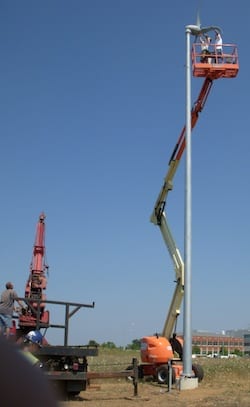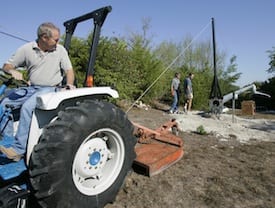 When one of its 170,000 wind turbines around the world breaks down, Southwest Windpower does what any good manufacturer does — it gets a field tech out there to check it out. But the company sends its techs with one word of warning: Don’t climb the towers. That’s way too dangerous.
When one of its 170,000 wind turbines around the world breaks down, Southwest Windpower does what any good manufacturer does — it gets a field tech out there to check it out. But the company sends its techs with one word of warning: Don’t climb the towers. That’s way too dangerous.
Wind turbines — those natural energy windmills you always see lining the highway in the most remote part of the state — are incredibly powerful and complicated machines, but like any other appliance, they break down sometimes, succumbing to the wear and tear of the outdoors and the constant use. And when they do, turbine repairs actually follow a pretty typical service structure, even for such a sophisticated contraption.
With customers all over the world (mostly business and residential turbines), Southwest Windpower typically directs customers to call up an authorized local dealer for service — often a smaller wind and solar company licensed to work on its turbines. “[Local dealers are] actually doing the field work — going out into the field, assessing the situation, getting an idea of what’s going on with the system,” said Michael French, a marketing manager for the company. “And then depending on what they find, they can either do some field repair or they might take the unit into their shop and do some additional diagnostics or replace parts.”
French said that many of Southwest Windpower’s turbines come with diagnostic software built into them, compatible with a ZigBee network (similar to Wi-Fi) and a PC, that lets the technician troubleshoot from the ground. In some cases, the customer can even run tests on an individual turbine within the system they use to monitor energy levels.
The towers range in height from 35 to 70 feet, typically. French said the company directs techs to either use a lift to get themselves up there for a repair — some turbines have a hatch within the turbine’s frame that techs can open and service directly from the lift — or to lower the towers to the ground with a gin pole and hinge-plate system and a truck with a winch (check out the photo).
 Technicians are trained during an annual week-long programs that are held all over the world, which focus on classroom and field projects. “The classroom environment is where you get the theory, the product info, and the background,” French said. “The field component is going out and lowering, raising, and troubleshooting an actual turbine.”
Technicians are trained during an annual week-long programs that are held all over the world, which focus on classroom and field projects. “The classroom environment is where you get the theory, the product info, and the background,” French said. “The field component is going out and lowering, raising, and troubleshooting an actual turbine.”
So while a background in engineering certainly helps, the biggest qualification to be a wind turbine field technician may ultimately be suppressing a fear of heights.
More: The Strange, Bloody, and Oddly Mundane World of Crime-Scene Cleanup.
Click here to download a free whitepaper, “Five Steps to Make Field Service Profitable.”

Share this: